|

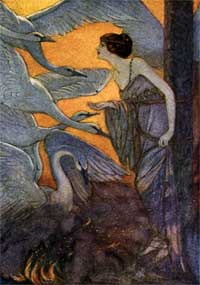 The Black and White Swan Ball: The Black and White Swan Ball:
The Northern Hemisphere species of swan have pure white plumage, but the Southern Hemisphere species are patterned with black.
The Australian Black Swan (Cygnus atratus) is completely black except for the white flight feathers on its wings, and the South American Black-necked
Swan has a black neck. The Coscoroba Swan, also from southern
South America, has black tips to the
primary feathers.
Bills and Legs, Bills and Legs: Swan legs are a dark blackish gray, except for the
two South American species, which have
pink legs.
Bill color varies; the three far northern species have black bills with varying amounts of yellow, and all the others are patterned red and black. The Mute Swan and Black-necked Swan have a lump at the base of the bill on the upper mandible.

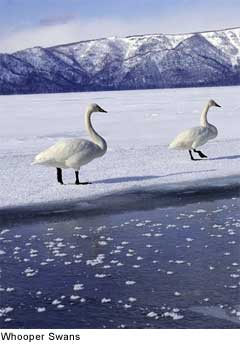 Swan Table Manners: Adult swan diets are almost entirely vegetarian. Their long necks enable the birds to reach far below the water's surface to chomp leaves and stems. Swan Table Manners: Adult swan diets are almost entirely vegetarian. Their long necks enable the birds to reach far below the water's surface to chomp leaves and stems.
Their powerful feet can also dig up lake bottoms to access roots and shoots. Newly hatched swans mainly eat water beetles and small crustaceans for the first three weeks of life.
In it For the Long Hall... Swans usually mate for life, though "divorce" does sometimes occur, particularly following nesting failure.
The number of eggs in each clutch is between 3–8.

Mute Swan: The Mute Swan (Cygnus olor) is a common Eurasian member of the duck, goose and swan family Anatidae.
Range and Habitat: This bird is found naturally mainly in temperate areas of Europe and western Asia. It is not migratory, although some populations must move in winter when waterways and lakes freeze. They are sometimes found at the coast, particularly in winter, rather than solely being birds of inland waters.
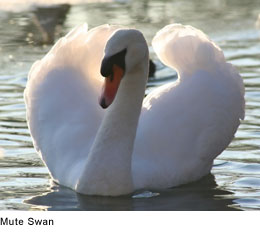 Swans Gone Wild: This species is often kept in captivity, in areas where it is not native, in order to decorate parks and ponds. The descendants of such birds have become naturalized in the eastern United States and Great Lakes, much as the Canada Goose has done in Europe. In some locations, such as Chesapeake Bay, the numbers of these feral birds have increased to the point where they are considered pests because they compete with native birds for habitat and food. Swans Gone Wild: This species is often kept in captivity, in areas where it is not native, in order to decorate parks and ponds. The descendants of such birds have become naturalized in the eastern United States and Great Lakes, much as the Canada Goose has done in Europe. In some locations, such as Chesapeake Bay, the numbers of these feral birds have increased to the point where they are considered pests because they compete with native birds for habitat and food.
Weights and Measures: Adults of this large swan range from 125-155 cm long with a 200-240 cm wingspan. They may stand over 1.2 m (four feet) tall. Males are larger than females and have a larger knob on their bill. The Mute Swan is one of the heaviest flying birds, with males weighing more than 12kg (27 lb), and females more than 11 kg (25 lb).
A Mute Beaut: The Mute Swan's size, orange-reddish bill and white plumage make this swan almost unmistakable. The most similar species is Whooper Swan, but that has a yellow and black bill, and lacks the curved "swan" neck, is longer and heavier and lacks the characteristic projection above the bill.
Protecting the Mute Swan: The Mute Swan is one of the species to which the Agreement on the Conservation of African-Eurasian Migratory Water birds (AEWA) applies.
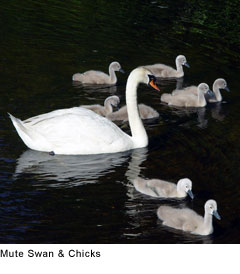 Swan Spawn: Young birds, called "cygnets", are not the bright white of mature adults, and lack the bright orange bill. Swan Spawn: Young birds, called "cygnets", are not the bright white of mature adults, and lack the bright orange bill.
The color of the down may be a dull white or gray, and controversy exists over whether the color is related to their gender.
Family Birds: Mute Swans nest on large mounds that they build in shallow water in the middle or at the edge of a lake. These monogamous birds reuse the same nest each year, restoring or rebuilding it as needed.
Male and female swans share the
care of the nest, and once the cygnets are fledged it is not uncommon to
see whole families looking for food.
They feed on submerged aquatic vegetation, reached with their long bills.
Swan Strength: Although this bird can be tame, especially to those who feed it daily, it is aggressive in defense of its nest, and its size and impressive hissing make it a formidable adversary for animals as large as a fox; a grunt, on the other hand, may be a positive signal. There have been many reports of Mute Swans attacking people who enter their territory. Their wings are believed to be so strong that they can break a person's arm with one hit, although the evidence for this is weak.
Swan Song: The Mute Swan is less vocal than the noisy Whooper and Bewick's Swans; the most familiar sound associated with Mute Swan is the whooshing of the wings in flight once this bird has 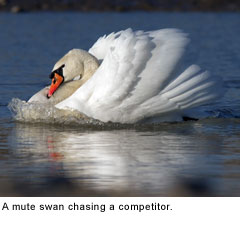 laboriously taken off from the water. The phrase swan song refers to this swan and to the famous ancient legend that it is utterly silent until the last moment of its life, and then sings one achingly beautiful song just before dying; in reality, the Mute Swan is not completely silent. laboriously taken off from the water. The phrase swan song refers to this swan and to the famous ancient legend that it is utterly silent until the last moment of its life, and then sings one achingly beautiful song just before dying; in reality, the Mute Swan is not completely silent.
No Trespassing: Unlike Black Swans, Mute Swans are strongly territorial. The familiar pose with neck curved back and wings half raised, known as busking, is a threat display. The Mute Swan is protected in most of its range, but this has not prevented illegal hunting and poaching in some countries.

Genus Cygnus
Whooper Swan, Cygnus cygnus breeds in Iceland and subarctic Europe and Asia, migrating to temperate Europe and Asia in winter. Whooper Swan is Finland`s national bird.
Trumpeter Swan, Cygnus buccinator is a North American species very similar to the Whooper Swan (and sometimes treated as a subspecies of it), which was hunted almost to extinction but has since recovered: it is one of the heaviest flying animals, at up to 17 kg (38 lb).
Whistling Swan, Cygnus columbianus is a small swan which breeds on the North American tundra, further north than other swans. It winters in the USA.
Bewick's Swan, Cygnus bewickii is the Eurasian form which migrates from Arctic Russia to western Europe and eastern Asia (China, Japan) in winter. The reserves of the Royal Society for the Protection of Birds and of the Wildfowl and Wetlands Trust in Britain are important for Bewick's and Whooper Swans. It is often considered a subspecies of C. columbianus, creating the species Tundra Swan.
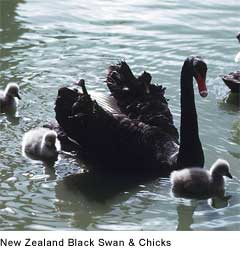 Black Swan, Cygnus atratus of Australia, and introduced in New Zealand. The Black Swan is the state emblem of Western Australia, Black Swan, Cygnus atratus of Australia, and introduced in New Zealand. The Black Swan is the state emblem of Western Australia,
and is also the symbol of the Sydney beach side suburb of Dee Why.
New Zealand Swan, Cygnus atratus sumnerensis or Cygnus sumnerensis, is an extinct sub-species of black
swan from the New Zealand and the
Chatham Islands.
Black-necked Swan,
Cygnus melancoryphus of
South
America, formerly Sthenelides melanocorypha.
Mute Swan, Cygnus olor, is a common temperate Eurasian species, often
semi-domesticated; descendants
of domestic flocks are naturalized in the United States and elsewhere.
Genus Coscoroba
Coscoroba Swan, Coscoroba coscoroba, also of South America
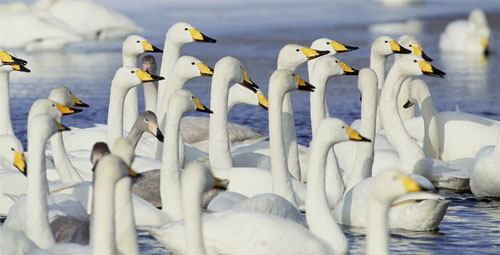
All text is available under the terms
of the GNU Free Documentation License
|